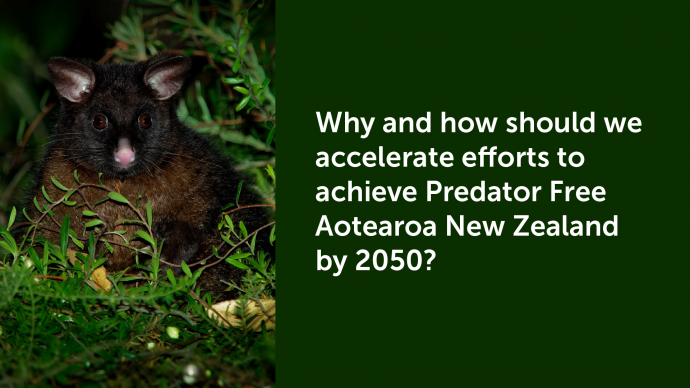Expert perspective: Katherine Short

Katherine Short, an expert in sustainable fisheries and caring for coastal habitats, calls for the same integrated approach used in terrestrial Predator Free 2050 to be adopted for marine conservation.
The kina challenge: coastal ecosystems out of balance
Kina (sea urchins) are native New Zealand taonga; however, coastal ecosystems are out of balance and we can inform how we address this by looking through a Predator Free lens. Overfishing of their natural predators (snapper, blue cod and crayfish) and warming seas have triggered a 700% increase in kina density since the 1990s. Today, kina barrens (barren reefs stripped of kelp by overgrazing) dominate 7–49% of shallow reefs in unprotected areas, with hotspots in the Hauraki Gulf, Queen Charlotte Sound and northeastern coastlines. These are becoming ecological deserts: once-vibrant kelp forests that supported fish, invertebrates, and carbon sequestration collapse into low-productivity zones.
Community and research-led removal and restoration projects offer hope. Iwi/Māori partnerships, such as initiatives being led by Ngāti Manuhiri and Ngāi Tai ki Tāmaki, have shown that manually removing kina triggers kelp regrowth within months. In Tōtaranui (Queen Charlotte Sound), giant kelp returned to 4.5-metre lengths after kina clearance. Similarly, the Te Kohuroa Rewilding Initiative (New Zealand’s first government-approved kina removal project) targets barrens in Matheson’s Bay. Love Rimurimu in Te Whanganui-a-Tara have also developed techniques for giant kelp (macrocystis) replanting, and its recovery can now be tracked by satellites. Yet these successes are temporary as Dr Kelsey Miller notes, "removing kina does not address the underlying cause of overpopulation... natural predator abundance remains low due to fishing". From fifteen years’ observation and work in this space, I would add that it’s the combination of overfishing and sediment that are stressing kelp forests and coastal ecosystems.
Learning from Predator Free: the power of layered strategies and stacked interventions
The terrestrial Predator Free 2050 movement excels by deploying stacked, integrated techniques in the same locations: combining traps, aerial baiting, fences, and community trapping networks. Importantly too the collaboration between the layers is resourced and there’s an area plan for all to work to. This "toolbox approach" compounds pressure on pests – both weeds and animals. For example, ecosanctuaries use physical barriers and ground control simultaneously, while landscape projects layer community action with biocontrol research. These collaborations have eradicated predators across 45% of targeted mainland areas. Joyfully, recently I saw two kererū fly past my Roseneath apartment windows… possibly on their way to the now predator free Motu Kairangi/Miramar Peninsula. This was the first time that I’ve ever seen kererū in Wellington east of Kelburn.
Currently, due to low investment in collaboration, marine conservation and management lacks these synergies. While tools exist i.e. kina removal, fishing reforms, marine reserves and predator recovery, currently they often operate in isolation. Importantly, with respect to Kina interventions, they are neither consistently occurring with or resourcing mana whenua involvement nor restoring predator populations. Fisheries New Zealand’s new special kina removal permit is a step forward, but it remains disconnected from a more strategic ecosystem-based management implemented with communities. The Habitats of Particular Significance for Fisheries Management programme offers hope too, finally unpacking Section 9(c) of the Fisheries Act, yet our marine environment dearly needs a national, strategic approach to marine planning and significantly scaled up care.
Unlike Predator Free’s unified framework, marine efforts are fragmented across community initiatives, researchers, and agencies—limiting impact. There is no ‘Moana Moonshot’ like the Predator Free 2050 vision and the massive marine area we’re responsible for needs us to step up and create one.
A call for stacked interventions and resourced collaboration
To restore kelp forests and coastal marine ecosystems, we must layer marine techniques as Predator Free does:
- Combine removal with predator recovery: Pair any kina interventions with thoughtful plans for the restoration and long-term care of the area.
- Scale community initiatives: Expand Māori-led projects and support the use of both mātauranga Māori and western science.
- Adopt an integrated approach towards "kelp forest restoration": Draw on the Sustainable Seas Science Challenges’ decade long research and findings to guide us how to deliver ecosystem-based management and kaitiakitanga in tandem – which although from different epistemologies, the Challenge found are closely related.
Without this, we are investing in unsustainable short-term fixes. If Predator Free teaches us anything, it’s that investing in the collaboration required to stack solutions in place - not scattering them - creates lasting change. Can New Zealand unite and scale marine efforts before kina barrens are the new normal?
Published July 2025
 Katherine Short
Katherine Short
Following a long WWF sustainable fisheries career, Katherine Short’s former business partnership Terra Moana supported Moana New Zealand for a decade in its sustainability journey. Now independently running F.L.O.W. Collaborative, her work focuses on caring for coastal habitats, upholding Te Ao Māori, and increasing funding for these vital efforts. Katherine was recently a mentor for rangatahi in the Society’s Powering Potential ki Poneke programme.
